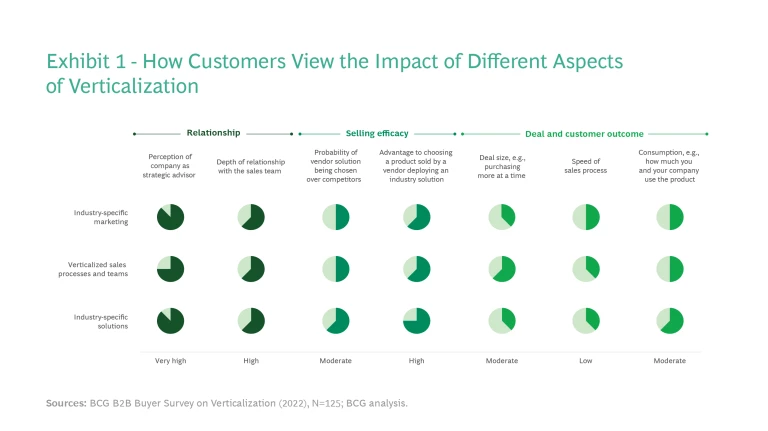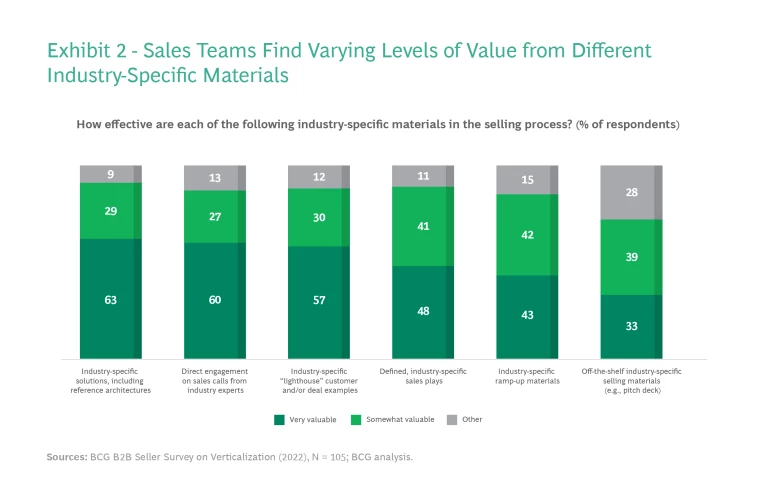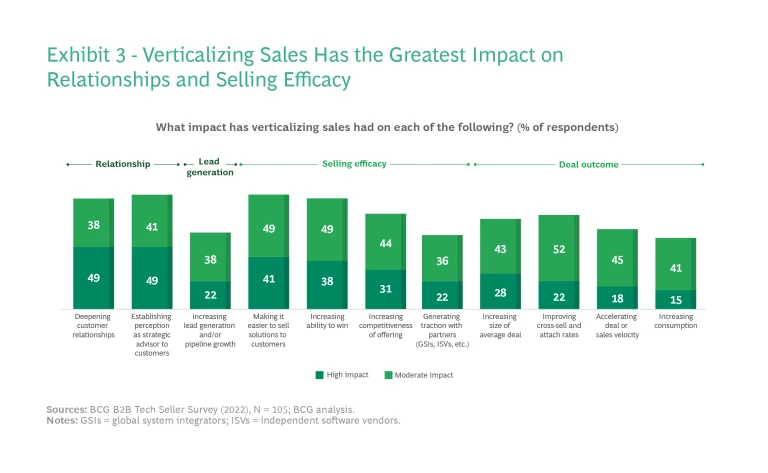A range of industry-specific challenges, from various regulatory requirements to fragmented technology stacks, have led today’s B2B software buyers to expect vendor solutions that are custom-fit for their distinct needs. In response, software companies are increasingly “verticalizing”—adapting their products, marketing, sales, and ecosystems to specific industry use cases—rather than relying on the broad applicability of “horizontal” products.
These efforts are paying off. Our analysis indicates that verticalization has a directional correlation of 10% to 20% with year-over-year revenue growth for B2B software businesses, on average. And buyers are welcoming the expertise of sales teams who really understand their industry. These and other findings from our research indicate that tech companies should either begin their verticalization journeys or accelerate their efforts if already on this path. Companies that continue their “vanilla” horizontal approaches risk not only being unable to differentiate themselves but also losing out to the competition that can. Here we discuss the trends driving the industry, the value to customers, and the decisions involved for software providers when adopting a vertical approach.
Trends Driving the Industry
Many mature software companies have already developed industry-specific solutions to address the challenges their B2B buyers face today, including varying levels of business complexity, fragmented technology stacks, unique business processes and workflows, and a range of regulatory requirements. Meanwhile, larger system integrators have organized their go-to-market efforts around industry verticals, and the market for verticalized software, already close to a quarter of the overall global software market, continues to attract new companies.
Our research finds that the trend of verticalization is accelerating, with more than 40% of software companies increasing their verticalization efforts in existing industries and almost a third expanding to additional industries.
Our research finds that the trend of verticalization is accelerating, with more than 40% of software companies increasing their verticalization efforts in existing industries and almost a third expanding to additional industries. And this acceleration is occurring across all layers of the technology stack. While the degree of verticalization is more extensive in the application and data layers, even software companies in the traditionally “horizontal” infrastructure and platform layers are verticalizing through innovative approaches such as industry-specific clouds. In fact, industry clouds have moved beyond early adoption, with many cloud users currently employing an industry cloud or having plans to do so in the next two years. Notably, our findings indicate that application companies appear to be increasing their efforts in existing industries as well as expanding into new ones, whereas data and analytics , infrastructure , and platform companies are focusing slightly more on industries they currently prioritize.
We also find that software companies are choosing to verticalize earlier in their growth. While companies used to begin verticalizing when they reached about $3 billion in revenue, we see empirical evidence that they are now starting at around $1 billion. Our analysis indicates that these efforts are working: verticalization has a directional correlation of 10% to 20% with year-over-year revenue growth for B2B software businesses, on average, jumping to 65% to 80% for companies with $1 billion to $5 billion in revenue.
The Value of Verticalization
To evaluate the impact of verticalization on buyers’ attitudes and vendors’ business outcomes, such as win rates and cross-selling, we conducted two in-depth surveys of B2B software buyers and sellers. (See the sidebar, “Our Methodology.”) The results show that sales teams find significant value from verticalization, and customers increasingly expect it.
Our Methodology
Our Methodology
In addition to the primary research conducted by BCG, our perspective was supplemented by data from various sources including Gartner and IDC.
Building credibility and differentiation with customers
As many as 80% of executive-level software buyers in our survey indicate that verticalized products and solutions have a moderate to very high impact on their purchasing decisions. While the results are strongest in application software—about 30% of buyers indicate moderate and more than 60% indicate high to very high impact—more than 75% of buyers of data, platform, and infrastructure software also indicate moderate to significant impact.
When asked for specific advantages of verticalization in the sales process, customers say that they see the most value in three areas: establishing a perception of the vendor as strategic advisor to its customers, deepening the relationship with the vendor’s sales team, and accelerating the selection of the product. In addition, buyers report a meaningful improvement in the vendor’s ability to edge out the competition, along with increased consumption and deal sizes.

While verticalized marketing, sales, and solutions all positively affect outcomes, customers ascribe impact in different ways. Our survey finds that a verticalized sales team lifts deal size the most, while industry-specific marketing most affects sales velocity, and industry-specific solutions most improve consumption. (See Exhibit 1.)
Nonetheless, the most important aspect of verticalization to customers is expertise. Buyers want someone who speaks their language, understands their needs, and can adeptly explain how a vendor’s portfolio will solve the specific challenges of their industry. In fact, 76% of buyers indicate the importance of having sales teams and management who really understand their industry, and more than two-thirds say they find value in industry-specific solutions, engagement from industry experts, and “lighthouse” customer success stories in their buying process.
Generating better sales outcomes

Critically, the value of verticalization is obvious not just to buyers, but to sales teams as well. Throughout the selling process, companies can equip their sales teams with industry-specific materials, from solution details to pitch decks, as well as access to industry experts. Sellers find particular value from verticalized solutions and reference architectures, as well as having industry experts join sales calls. (See Exhibit 2.) The former indicates the advantage gained by software companies in directly addressing priority use cases and outcomes enabled by their technology, while the latter underscores the importance of an in-depth understanding of the issues and challenges of a customer’s industry.
In our research, 87% of sellers found value in industry experts joining sales calls. Sales and industry leaders at B2B software companies shared success stories from sellers that help explain why. For example, one B2B robotic process automation company included pharma experts on sales calls to explain how its bots could work with a large customer’s existing tools and precisely how they would add value. As a result, the deal size increased from 10 to 500 bots, and the seller closed the deal faster while displacing the incumbent competitor. Similarly, a communications vendor hired experts from the education sector who had experience and Rolodexes with large state university systems. The company shifted from selling to individual university campuses to closing systemwide deals ten-fold in size.
The impact of verticalization spans the entire sales cycle—affecting deal size and deal velocity and creating a competitive edge.
We also heard numerous other examples illustrating that the impact of verticalization spans the entire sales cycle—affecting deal size and deal velocity and creating a competitive edge. While sellers report the most value in deepening customer relationships and bolstering their own credibility, they also find meaningful benefits with respect to selling efficacy and improving deal outcomes such as consumption. (See Exhibit 3.)

To achieve these advantages, companies are building vertical-specific processes into their sales cycles. For instance, a data services company improved its quarterly business “success” reviews with customers in the banking sector by adding industry experts to ensure that customers were unlocking the full potential value and maximizing the consumption of the products they purchased. The engagement surfaced opportunities to upsell even more comprehensive solutions—enabling the company to expand its footprint by up to four times the size of the initial sale.
Typically, sellers at smaller, early-stage companies have the greatest top-line uplift potential from verticalization, with many experiencing 10% to 20% improvement in their win rates and the speed of their sales cycles. Meanwhile, larger, more mature companies see greater than 20% improvement in consumption and in cross-sell and attach rates, as well as in retention.
Subscribe to receive the latest insights on Technology, Media, and Telecommunications.
Capitalizing on the Opportunity
While there is clearly significant value to be realized through an industry strategy and
go-to-market approach
, verticalizing everything everywhere will not likely be a sound tactic. Instead, software companies need to thoughtfully choose the verticalization path that best suits their customers’ needs, ability to scale, and resources. Once they have defined their strategy, success will come from verticalizing to the right degree in each of the following areas:
- Sales. As mentioned before, to better connect with their customers’ decision makers, companies can have a pool of industry experts available to join sales calls; they can align their presales (business development, inside sales), field sales, and post-sales (customer success, professional services) vertically; and they can build industry-specific sales plays as well as value-engineering expertise.
- Marketing. Companies have the option of dipping their toes into industry-based marketing by adding a veneer onto their existing horizontal messaging and materials. But several successful companies have waded much deeper by investing in solutions marketing that targets specific industry use cases and highlights lighthouse customer examples.
- Product. Businesses must choose from a gamut of options to adjust and evolve their products to better fit in certain industries. These can range from developing industry-specific features in their current products to launching fully verticalized products or assembling a portfolio of solutions that combine vendor and partner IP.
- Ecosystem. Different types of partners in modern software ecosystems often have a very strong vertical focus. The right partnerships can be tremendous accelerators in verticalization for software vendors. This acceleration can come by working with existing partners’ industry-aligned go-to-market motions or by collaborating on vertical-specific solutions, such as independent software vendors (ISV) applications, to address individual customer use cases.
The right partnerships can be tremendous accelerators in verticalization for software vendors.
Apart from choosing the appropriate degree of verticalization, the journey could involve several additional steps, and care is needed to avoid common pitfalls, particularly for companies just beginning to verticalize. Some elements needed for success include the following:
- Prioritize the appropriate industries. It can be tempting to tackle too many industries, but businesses risk diluting their efforts by stretching themselves too thin. Instead, they should target industries based on their business potential, the chance of consistent success, and the importance of a verticalized approach to customers. It is also critical to acknowledge differences across sub-sectors in an industry: what it takes to win and the size of the prize can be markedly different and require specific tailoring.
- Identify high-value problems to solve in target verticals. Businesses should develop an understanding of the biggest pain points within each target vertical or sub-vertical that may be addressed by their solutions and then prioritize their efforts based on returns and scalability across customers. Companies that have verticalized successfully are disciplined and systematic in this use-case prioritization.
- Invest in verticalized sales, marketing, products, and an ecosystem as needed. Once companies have identified the suitable level of verticalization in these four areas, it is critical to ensure an adequate level of investment. Success also requires establishing the right industry-based operating model with appropriate cross-functional coordination and accountabilities.
- Expand the approach to other industries. After finding success in their prioritized industries, businesses should scale to additional industries. However, this is not a “rinse and repeat” of what worked in the initial efforts; care must be taken to identify the degree to which sales, marketing, products, and the ecosystem need to be verticalized for each new industry.
B2B technology providers have a major opportunity to build sustainable advantage through a clear, industry-focused approach.
Technology buyers continue to face fundamental changes in their industries, and they expect software providers to demonstrate industry leadership to help them navigate. B2B technology providers have a major opportunity to build sustainable advantage through a clear, industry-focused approach; companies that ignore this trend risk eroding their relevance in the market. A winning verticalization effort will require more than just tinkering on the edges, but evidence suggests that the rewards at stake for companies that get this right are high.









